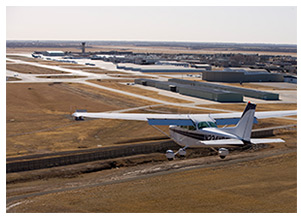Training Tips
|

'Proper spacing is critical'
Rolling out of the turn from base to final, a soloing student pilot reduces power to maintain a proper glide path while keeping an eye on the preceding arrival, which should soon taxi clear.
"What's he doing down there?" the student wonders when it becomes apparent that the aircraft below appears in no haste to vacate the runway. And with another trainer entering the pattern's downwind leg, the student is starting to feel a bit squeezed.
Brushing aside the distracting combination of perplexity and annoyance, the student pilot begins to react to the unfolding complications by slowing down promptly and mentally preparing for a go-around. If the aircraft ahead has not cleared by a point certain, the landing will be rejected.
What else can be done? Re-announcing the aircraft's position on final is a good idea (but this is not the time to initiate a discussion about traffic pattern etiquette, tempting as that may seem).
Is your landing light on? It should be—even in broad daylight. Perhaps the dawdler below will see it while turning toward the nearest taxiway, and expedite!
Many training scenarios lead a pilot to the decision to perform a go-around. Most of the balked-landing scenarios are based on correcting imprecisions in your own flying—things like being too high on final, or having difficulty maintaining directional control in gusty winds. It's exasperating to have to go around from a perfectly well flown approach thanks to the actions or thoughtlessness of another pilot.
But here's a question: Was it entirely the other fellow's bad flying at fault?
Take some time before the next flight to re-examine your own pattern procedures; it's often observed that many pilots fly the same rote-learned traffic pattern regardless of emerging circumstances that call for using precise procedures to maintain a safe margin.
For example, this excerpt from arrival procedures used at one of the 2014 AOPA regional fly-ins reminded inbound pilots to "ensure that you have at least a half-mile minimum separation between you and the aircraft you are following. Proper spacing is critical so please pay attention to airspeed and minimum separation," it said.
Note that this was guidance for minimum separation. Then, next time you fly the pattern at your own airport, remember that even without a fly-in in progress, "proper spacing is critical."
|
|
Flight Training News
|
|
Article
Reasonable club costs and affordable flight training are among the benefits of joining Oregon's Chief Joseph Flyers flying club.
Read more...
 
Flash-based, login required
Understanding aerodynamic principles involving maneuvering flight doesn't have to involve reciting dry textbooks and dense equations. The Air Safety Institute's Essential Aerodynamics: Stalls, Spins, and Safety helps you grasp need-to-know concepts to avoid unintentional stalls and spins.
Take the course...
Apps of the week
Apps that help with flight planning, track flights, and calculate weight and balance are among the favorites submitted by AOPA members.
Read more...
 

Article
AOPA has lined up an array of menu options for those attending the third regional AOPA Fly-In in Plymouth, Massachusetts, July 12. Lunch will be served from the best kitchens (and chefs) on wheels in the region.
Read more...
 
Digital newsletter
Whether you're an active flight instructor or getting back into the cockpit, you can access the Air Safety Institute's free digital quarterly flight instructor newsletter anywhere, anytime. See the video of a CFI's "Real Pilot Story," explore ways to improve your radio communication with ATC, and come along with Rod Machado on an experiment of flying under the influence of density altitude. Not a CFI? No problem. Subscribe here.
Read the latest issue...
NAFI sponsors MyGoFlight's iPad EFB challenge
Pilots looking to make the transition from a paper cockpit to using an iPad as an electronic flight bag (EFB) may get help through a new effort by the National Association of Flight Instructors (NAFI) and MyGoFlight. NAFI is sponsoring the iPad Takes Flight! EFB Challenge Edition, a seminar and contest that builds on MyGoFlight's iPad Takes Flight! seminar series. The seminar and contests will have questions that explore aspects of flight planning and preflight and in-flight decisions pilots must make in VFR and IFR situations. Winners can advance to regional contests and eventually a national contest.
|
Training Resources
|
|
The engine and propeller are the heart and lungs of any aircraft, and as such, need special care. Many repairs can only be made by an airframe and powerplant mechanic. Take this online Air Safety Institute course for a better understanding of engine and propeller operations so you can help minimize dangerous wear and costly repairs.
Take the course...
|
|
Did you know that student pilots who join AOPA are three times more likely to complete their flight training? Membership includes unlimited access to aviation information by phone (800/USA-AOPA, weekdays from 8:30 a.m. to 8 p.m. Eastern time) or from Flight Training Online or AOPA Online. If you're not already a member, join today and get the pilot's edge.
|
AOPA Live
|
|
AOPA Live This Week
A runway incursion in Barcelona, Spain, got plenty of media attention recently, though it may not have been quite as hairy as some would have you think. AOPA Live® chats with AOPA Foundation President Bruce Landsberg about the lessons, including "look both ways." Plus, the show takes you to Plymouth, Massachusetts, for a look at what makes it a perfect place for an AOPA Fly-In, and returns to San Marcos, Texas, for some unconventional taxi lessons.
AOPA Live This Week®, July 10...
 
|
|
Career Pilot
|
Southwest launches international service
Southwest Airlines launched its first international service July 1 with flights to three Caribbean destinations from three of its U.S. gateway cities. New service links Baltimore/Washington International Airport with Oranjestad, Aruba; Montego Bay, Jamaica; and Nassau/Paradise Island in the Bahamas. International service also began from Atlanta and Orlando. Earlier, Southwest announced that all international service offered by wholly owned subsidiary AirTran Airways, including flights to Mexico and the Dominican Republic, would convert to Southwest before the end of 2014.
Great Lakes considering fleet configuration, business strategy
Regional airline Great Lakes Aviation Ltd. announced June 30 that it has engaged Raymond James as its investment banker to advise the company about new financing options and strategic alternatives, as well as to help evaluate changes to its business and fleet configuration. In March, the company certified new FAA operations specifications that have enabled it to hire pilots despite recent regulatory changes that have reduced the number of qualified pilot applicants for the regional airline sector. Recent reductions in air service to small communities across the country—also impacted by the pilot supply—necessitate a reinvention of the regional airline industry, the company said.
|
|
For more aviation career news, see the Flight Training website.
|
Plane Spotter
|

Bolts from the blue
An amateur-built aerobatic biplane whose pilot can share the fun with a passenger might seem like a cool but cramped concept—but that's not the case where Steen Skybolts are concerned. In fact, capaciousness was one of the highest design priorities of designer Lamar Steen, whose students in a high school shop class reportedly built the prototype aircraft; it flew in 1970. Now there are more than 450 Skybolts and variants under U.S. license, powered by a wide variety of engines. About 200 more Skybolts are found around the world.
|
Training Products
|
Machado offers sport pilot handbook
With more than 1,000 illustrations and photos, the 582 full-color pages of Rod Machado's Sport Pilot Handbook make preparation for the FAA sport pilot oral and knowledge exams—and flight reviews, too—a fun experience. The cost is $59.95 for the book and $44.95 for the e-book.
Comm1 offers VFR online communications course
Talking on the radio is one of the most important, but least emphasized, skills student pilots need to fly safely in busy airspace. Comm1's VFR Pilot Communications Training on CD-ROM helps students get up to speed on communicating professionally with air traffic control, flight service, Flight Watch, and other ground personnel. The cost is $93.95.
|
|
Note: Products listed have not been evaluated by ePilot editors unless otherwise noted. AOPA assumes no responsibility for products or services listed or for claims or actions by manufacturers or vendors.
|
Member Benefits
|
|
Members only
Pilots may not be aware that certain drugs may produce adverse side effects that can affect cognitive function, including reaction time, judgment, and decision-making skills.
Read more...
 
Member benefits
AOPA member Frank Sperandeo converted his tricycle landing gear airplane into a taildragger to get rid of drag and increase speed. He chose AOPA insurance for coverage of the award-winning Piper Pacer.
Read more...
 
|
Blogs
|
|
Check out tips to keep cool in the cockpit.
Read more...
 
|
Instrument Tip
|
|
IFR Fix
No one ever said that pilots flying raw-data approaches had sacrificed their airmanship on the altar of technology. Would your raw-data instrument skills stand up to the challenge of a low-tech instrument proficiency check?
Read more...
 
|
Final Exam
|
Question
How does true altitude differ from absolute altitude?
Answer
True altitude is the height of the aircraft above sea level. This is often expressed in feet mean sea level (msl). Absolute altitude is the height of the aircraft above ground level (agl). (Source: Pilot's Handbook of Aeronautical Knowledge, Chapter 7.)
|
|
Got a question for our technical services staff? Contact AOPA.
|
Career Opportunities
|
|
AOPA career opportunities
Ever dream of turning your passion for aviation into a career? We're looking for an administrative assistant for communications, aviation technical specialist, Air Safety Institute intern, member services representative, major gift officer, AOPA Live producer/videographer I, and account manager II. To learn more about other AOPA career opportunities,
visit AOPA Online.
|
 |
Education and Seminars
|
Flight Instructor Refresher Courses
July 12-13 - Memphis, Tennessee; and Pittsburgh, Pennsylvania
July 19-20 - Jacksonville, Florida; and Newark, New Jersey
Aug 2-3 - Fort Worth, Texas
Aug 9-10 - Reno, Nevada; and Allentown, Pennsylvania
For a complete schedule, see AOPA Online. Can't make it in person? Sign up for the Air Safety Institute's new Online eFIRC.
|
Air Safety Institute Safety Seminars
July 31-Aug 2 - Oshkosh, Wisconsin
Sep 2 - Germantown, Tennessee
Sep 3 - Salt Lake City, Utah; and Murfreesboro, Tennessee
Sep 4 - Boise, Idaho; and Maryville, Tennessee
Topics vary—for details and a complete schedule, see AOPA Online.
|
Rusty Pilot Seminars
July 11 - Plymouth, Massachusetts
July 12 - Terre Haute, Indiana; and Perry, Georgia
July 16 - Independence, Oregon
July 19 - Englewood, Colorado; Hillsboro, North Dakota; and Burlington, Washington
For a complete schedule, see AOPA Online.
|
|
Aviation Calendar
|
|
Want something to do this weekend? Planning an aviation getaway? See AOPA's enhanced calendar of events. Now you can filter events by date range, airport ID, state, or region. Before you take off on an adventure, make sure you check our current aviation weather provided by Jeppesen.
To include an event or to search all events in the calendar, visit AOPA Online. For airport details, including FBO fuel prices, see AOPA Airports.
AOPA Featured Events
Jul 12 — Plymouth, Massachusetts. Plymouth Airport (KPYM). AOPA Fly-In.
Aug 16 — Spokane, Washington. Spokane Felts Field (KSFF). AOPA Fly-In.
Sep 20 — Chino, California. Chino Airport (KCNO). AOPA Fly-In.
Oct 4 — Frederick, Maryland. Frederick Municipal Airport (KFDK). AOPA Homecoming.
Nov 8 — Brunswick, Georgia. Malcom McKinnon Airport (KSSI). AOPA Fly-In.
|
|
|
|
 |
|
|
ePilot Flight Training Editor:
Benét Wilson
Production Assistant:
Melissa Whitehouse |
Contributors:
Sarah Deener
Alyssa Miller
Jim Moore
Jill W. Tallman
Warren Morningstar
Alton K. Marsh
Dave Hirschman
Tom Horne
Ian J. Twombly
Dan Namowitz |
|
|
|
|